| Heavy Tanks of the JS Series |
|---|
|
|
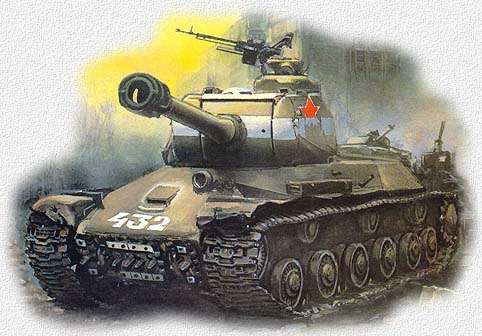
| Heavy Tanks of the JS Series |
|---|
|
|

| Note: All Russian terms and abbreviations shown as red italic are described in the Glossary. |
The predecessors of the JS-1 and JS-2 tanks were the KV-1 Heavy Tank and Heavily Armoured KV-13 Medium Tank (see photo to the left). The KV-13 (and its subsequent version - Object #233) became the first major independent project of the Experimental Tank Factory, created in March 1942 in Chelyabinsk from Design Bureau #2. N.V.Tseits, who had been recently released from a GULag, was appointed head designer of the project. Other members of the design team were K.I.Kuzmin (hull), N.M.Sinev (turret), S.V.Mitskevich (chassis) and G.N.Moskvin (general assembly). The KV-13 was designed as a universal tank - medium tank weight and heavy tank protection. This project was distinguished by its extensive use of cast armour. Casting was used not only for the turret, but also for the main elements of its hull - the glacis, turret ring and rear. This reduced the usable internal space, but increased the effective armour protection whilst reducing the amount of armour needed for its manufacture. The last point was especially important in light of the State Defense Committee's decree of 1942 to minimise the consumption of armour materials. The first test unit was designed and produced in an extremely short period of time and in May of 1942 it was delivered to the factory testing facilities. The tank weighed 31.7 tonnes and was armed with a 76.2 mm ZiS-5 gun and a coaxial DT TMG. |

The maximum front armour thickness of its hull was 120 mm, that of its turret - 85 mm. Its V-2K 600 h.p. engine allowed it to reach speeds of up to 55 km/h. Elements of the T-34's chassis, including tracks, were used, whilst the road wheels were taken from the KV.
The KV-13 had an improved (U-shaped) radiator similar to the one previously used on the Kirov Factory variant of the T-50 tank. This allowed for a more efficient engine block configuration and also increased the efficiency of its air intake. Several flaws surfaced during the testing of the first experimental unit of the KV-13: poor acceleration due to transmission problems, tracks and rollers easily damaged, tracks being thrown while making turns, etc. In July 1942, in the middle of its testing, the head designer N.V.Tseits died and N.F.Shamshurin was appointed in his place. On his initiative the KV-13 received the transmission developed by F.A.Marishkin for the KV-1S, as well as some other parts of its chassis. However, even after these improvements, the tank did not pass its tests and the military quickly lost interest in it. Despite these early failures, in December of 1942 the assembly of two new variants of the KV-13 began at the Experimental Tank Factory. The new vehicles shared only the hull, torsion bar suspension, and chassis from the first version. The turrets and many other elements were completely new designs. The transmission used was significant in its use of a planetary 2-step travesing gear designed by A.I.Blagonravov. The cooling system was improved, while the track links were lightened by making every other link flat (the so-called "Chelyabinsk tracks"). |
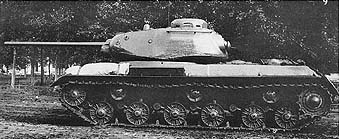
The appearance of the German heavy Tigers on the Eastern Front played a direct and decisive role in increasing the speed of development of these new models. According to decree #2943ss of the GKO (February 24, 1943) the Kirov factory in Chelyabinsk and factory #100 (the new name of the Experimental Tank Factory) of NKTP were to manufacture two experimental tanks of the "Josef Stalin" (JS) class (based on the two latest models of the KV-13) and prepare them for testing. The model armed with a 76.2 mm gun was designated JS-1 (also retaining its factory designation: "Object #233"). The second model, armed with a 122 mm U-11 tank howitzer (designed for the experimental heavy tank KV-9) was designated JS-2 (Object #234). |
Both models were tested between March 22 and April 19, 1943 and in general performed quite well. The state commission noted that both JS tanks weighed less than the KV-1S, could achieve higher speeds, had better armour protection and had equal (JS-1) or better (JS-2) armament. During testing, serious defects were discovered, particularly with the chassis and engine/transmission. It was also noted that when moving over soft ground the tanks experienced high rolling resistance due to their treads flexing into the space between the road wheels. The commission recommended increasing the number of road wheels on future test units of JS tanks. |
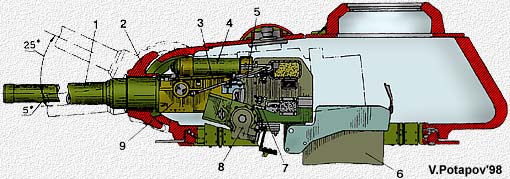
|
1. The barrel; 2. The mantlet; 3. The telescopic sight 10T-5; 4. The recoil brake; 5. The driving gear of the periscopic sight PT4-15; |
6. The bag for cartrige-cases; 7. The elevation level; 8. The lifting mechanism; 9. The gun-cradle |
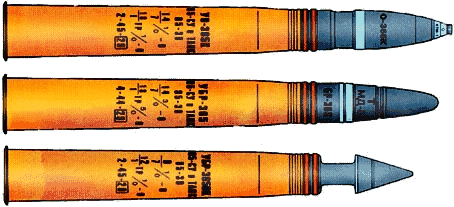 - the UO-365 fragmentation shell; - the UBR-365 armor-piercing shell; - the UBR-365P armor-piercing sub-calibre shell. |
At the same time preparations for production of the new vehicles began at the Chelyabinsk Kirov Factory (ChKZ), Factory #100 and their main partner factories- the Ural Factory of Heavy Machinery (UZTM) and Factory #200. However, further developments forced major changes in these preparations. In early April, the first reliable data on the armour protection of the Tigers was obtained. On April 15, 1943, the GKO issued the decree #3187ss instructing the People's Commissariat for Armaments to develop more powerful anti-tank guns capable of destroying the new enemy AFV's. At the end of April, a captured Tiger was brought to the Kubinka testing grounds to be subjected to firing tests. It turned out that the most effective weapon against it was the 85mm AA-gun 52-K model 1939, which penetrated the Tiger's 100 mm frontal armour from 1000 metres. The GKO's decree #3289ss of May 5, 1943, instructed the Design Bureaus to aim for the performance characteristics of that gun. Following this decree the Central Artillery Design Bureau (TsAKB), under V. G. Grabin, and the Design Bureau of Factory #9, under F. F. Petrov, were entrusted with developing and installing new 85-mm guns on two KV-1S and two experimental JS tanks. |
In the first half of June, four guns (two S-31s of the TsAKB and two D-5Ts of Factory #9) were ready. The S-31 was the result of mating the 85mm barrel with the base of the 76.2mm ZiS-5 tank gun, which greatly simplified its manufacture. As for the D-5T, it was a variant of the D-5S gun developed for the SU-85 self-propelled gun and was characterised by its low weight and light recoil. Right from the start it was obvious that it would be impossible to install an 85 mm gun in an unmodified JS turret without greatly degrading the crew's working space. It was therefore decided to increase the turret's dimensions, increasing the size of the crew compartment, which required the lengthening of the tank's hull by 420 mm. An extra road wheel was added to compensate for the increased distance between the second and third road wheels. The new turret was cast at Factory #200. All these changes resulted in an increase of the tank's weight to 44 tons and a reduction in its mobility. Such was the price of a more powerful gun. The JS with an 85mm gun was designated "Object #237". In the beginning of July 1943 two experimental vehicles - one with an S-31 gun and one with a D5-T gun - were produced. |
At the same time the ChKZ prepared two designs for the installation of the 85mm gun on a KV-1S. The first variant - "Object #238" - was a production KV-1S with a S-31 gun in its unmodified turret. The second - "Object #239"- received the turret from "Object #237" with a D-5T gun. In July 1943, all four tanks underwent comparative test. Based on the results of these tests, the D-5T gun, Object #237, and Object #239 gave the best results and were accepted for serice, whilst "Object #238" was cancelled due to the extremely small crew compartment hindering the normal functioning of the crew. Meantime both Object #237, and Object #239 were renamed as JS-85 and KV-85 respectively. On July 31 the KV-85 and JS-85 were delivered to the Kubinka proving grounds for tests, accompanied by twenty eight engineers led by the chief engineer of Factory #100, Mr. N.M.Sineev. The tests were started on August 2 by the Commission under the head of the Technical Administration of the Red Army, Major-General S.A.Afonin. The artillery tests were performed at the Gorokhovetsky Proving Ground. Based on the results, the Commission recommended both tanks for production. On the 8th of August, a column of experimental AFVs passed through the streets of Moscow into the Kremlin. Here, they were examined by Stalin, Molotov, Voroshilov, Beria and others. Interestingly, for the purpose of this display, all the crew except the drivers were replaced by NKVD officers. |
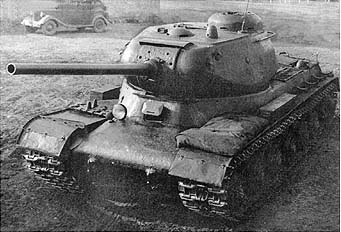
On the 4th of September 1943, the JS-85 heavy tank entered service with the Red Army as ordered by GKO decree #4043ss. The same decree ordered Factory #100 (in cooperation with the Technical Administration of the Red Army) to develop, manufacture and test an JS tank armed with a 122mm gun by October 15, 1943, as well as a self-propelled gun on the same chassis (JSU-152) by November 1, 1943. The first person to suggest arming the JS tank with a gun larger than 85 mm was the Director and Chief Designer of Factory #100, Zh.Y.Kotin. He realized in August 1943, after studying the results of the Kursk battle, that the most effective anti-tank weapon employed against German Tigers was the Corps 122 mm Field Cannon A-19 Model 1931. The designers at Factory #9 came to the same conclusions as Mr. Kotin, and designed the D-2 Heavy Anti-Tank Cannon by marrying the A-19 barrel with the carriage of the Divisional 122 mm Howitzer M-30. This powerful weapon was ordinarily employed against heavy tanks as an anti tank gun. The barrel of the gun was built into the gun carriage of the M-30 and the resulting gun successfully passed its tests, it became possible to install the A-19 gun in a heavy tank by using recoil-absorbers, elevation mechanism, and other mechanisms from the Experimental 122 mm Tank Howitzer U-11. This was done in a similar fashion to the 85mm guns D-5T and D-5S, but it was also necessary to add a muzzle brake. |
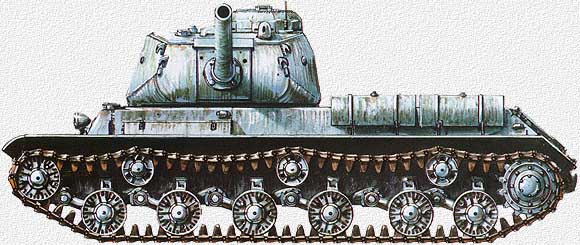
Having received the necessary design papers from Factory #100, the Design Bureau of Factory #9 promptly prepared a draft design for the A-19 gun in the JS-85 turret and sent it to Moscow with J.Kotin. The People's Commissar for Tank Industry V.A.Malyshev (A People's Commissar is like a Minister) liked the project and Stalin approved it. The JS tank with a 122 mm gun entered service with the Red Army on the release of GKO decree #4479ss dated October 31, 1943. This decree also charged Factory #9 with manufacturing a tank variant of the A-19 gun with a piston-type breech by November 11, 1943 (to be delivered for firing tests by November 27). At the same time the factory was ordered to start manufacturing this gun with a wedge-type breech in 1944. It was also decided to allow production of several 100 mm guns for testing on JS tanks.
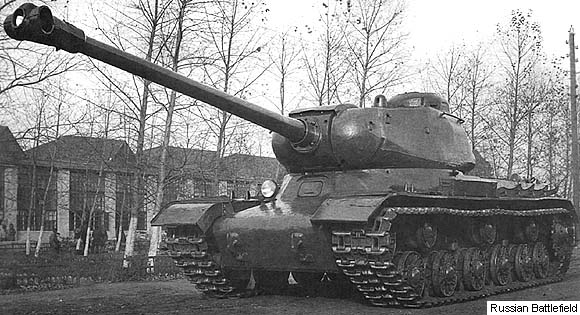
The first example of the A-19 tank gun was ready on November 12, 1943 - the barrel of the D-2 gun was removed from the M-30 gun carriage and installed in the D-5T base after after reducing its diameter. The T-shaped muzzle brake design was borrowed from the D-2 gun. The unusual muzzle brake was intended to reduce the main disadvantage of any muzzle brake: when a shot is fired, a large cloud of dust is kicked up from the ground, revealing the position of the tank. The T-shaped muzzle brake was intended to minimise any dust plumes due to firing. The JS-122 (Object #240) passed the Government tests quickly and successfully. Thereafter, the tank was moved to one of the Moscow military testing grounds where it was demonstrated to K.E.Voroshilov. The tank's 122 mm gun was fired from 1500 metres at a captured German Panther tank. The round hit the side of the Panther's turret, penetrating it cleanly and tearing the opposite side out at the welded seams, throwing it back a few metres. During these tests the muzzle brake of the A-19 blew up almost killing Voroshilov. After this accident it was decided to change the muzzle brake to a 2-chamber design similar to that used by the Germans. |
 T-shaped |
 Of the "German type" |
 Of the TsAKB construction |
The first part of production JS-1 tanks was delivered in October of 1943, and the JS-2 - in December. At the same time ChKZ continued to manufacture KV-85 tanks until the end of 1943. In January of 1944 the last 40 JS-85s were manufactured at the ChKZ. After this, it produced only the JS-122. These mounted the new 122 mm Tank Cannon D-25T with a wedge-shaped semi-automatic breech, which allowed an increased rate of fire from 1-1.5 shots per minute to 1.5-2 shots per minute. In March 1944, the "German-type" muzzle brake was replaced with a better design from the TsAKB. At the same time, the JS-85 was renamed JS-1, and the JS-122 was renamed JS-2. At this stage, the issue of the JS-2's armament was not completely resolved. The military was not satisfied with its low rate of fire and limited ammunition stowage - only 28 two-piece rounds (compared to the 59 one-piece rounds for the JS-1 and 114 one-piece rounds for the KV-1S). |

Further, after the first encounters between the JS-2 and German heavy tanks, it turned out that the sharp-nosed 122 mm APHE round - the BR-471 - could only penetrate the frontal armour of a Panther up to 600-700 metres. The less powerful frontal armour of a Tiger could be penetrated at distances up to 1200 metres. However, at such distances only very well trained and experienced gunners could score a hit. The vertical armour of a Tiger I, although thicker than that of a Panther, was more easily defeated by the sharp-nosed projectile of the JS-2 Main Gun, whilst it often ricocheted off the sloped armour of a Panther. Later, Soviet designers noticed the blunt-nosed projectiles worked fine against sloped armour. After several tests, designers revealed the effect of "normalisation" (Read more about "normalization" effect here). The powerful HE round, OF-471, when fired at German tanks, caused cracking and could even completely tear off the front armour plate at the seam weld. The first results of the IS-2 in combat (backed by the results of its tests at the Kubinka testing grounds in January of 1944) forced designers to look for new solutions to its problems. However, in the summer of 1944, the problem of the poor AP performance disappeared. The performance of the D-25T gun of the JS-2 against the German tanks improved dramatically. The reports from the front described cases where the BR-471 APHE round 122 mm projectile fired from 2500 metres ricocheted off the front armour of a Panther leaving huge holes and cracks in it. This was explained by an interesting change of circumstances in the Summer of 1944. The Germans experienced a shortage of manganese and had to switch to using high-carbon steel alloyed with nickel, which made armour very brittle, especially at the seam welds. The first encounters of JS-2 tanks with the Germans also showed that the front protection of its hull was not impenetrable. In the beginning of 1944, an attempt was made to improve the protection of the JS-2 by tempering the front armour to very high hardness. In practice, it led to a drastic increase in the number of components needed for the hull and significantly increased the cost of the tank's production. In March 1944, firing tests were conducted with a 76.2 mm Gun ZiS-3 firing at an JS-2 tank from 500-600 metres. The tank's armour was penetrated from all sides of the tank. Whilst while most of the projectiles did not penetrate the armour completely, they created major splintering and fragmentation inside the turret. This explains the considerable losses of JS-85 and JS-122 tanks during the Winter-Spring of 1944. |

In February of 1944 the Central Scientific Research Institute #40 (TsNII-40) was delegated the task of researching the armour protection of the JS-2 heavy tank. The research showed that, given the existing shape of the front of its hull, the tank would be invulnerable to penetration by any German 75-mm and 88-mm AP projectiles only if the hull's armour thickness were increased to at least 145-150mm (i.e. an addition of 20-30 mm thickness).

On the recommendation of the TsNII-40, new specifications for armour tempering and a new design for the front of the JS-2's hull were developed. The new hull, with a straightened glacis, preserved the same armour thickness while the plug-type driver's hatch was removed, greatly increasing its protection from the front. The glacis was sloped at 60 degrees from the vertical, which resulted in the German 88 mm KwK 36 gun being unable to penetrate it even at point-blank range when fired at a �30 degrees angle.
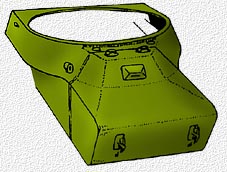 |
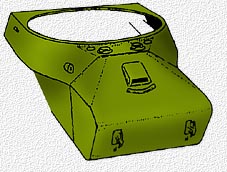 |
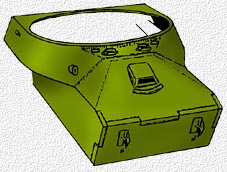 |
| The nose shape of the first production JS-1 and JS-2. | The cast "straight" nose shape of the JS-2. | The welded nose shape for JS-2 tank. Only UZTM produced tanks with this nose. |
However, the lower front hull armour plate, sloped at 30 degrees from the vertical, remained vulnerable. To increase its slope would require significant alteration to the layout and design of the driver's compartment. Since the probability of a hit on the lower part of the hull was low, it was decided to leave the design unchanged. From July 15 1944, spare tracks were attached to the lower hull to increase its protection. In May of 1944, the UZTM plant started manufacturing the new straightened welded hulls. Factory #200 began making the new type of hulls from June of 1944, but these were cast, not welded. However, for a while, tanks with old and new hull-types were produced simultaneously.
 Cast (prior to 21.12.1943) |
 Cast (prior to June 1944) |
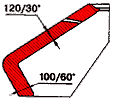 Cast (from summer 1944) |
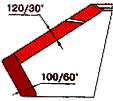 Welded (from summer 1944) |
As for the tank's turret, it turned out to be impossible to increase its armour protection. Designed for the 85 mm gun, it was completely balanced. After installing the 122 mm weapon, the turret became very unbalanced. The Design Requirements intended for an increase of its frontal armour thickness to 130 mm which would have unbalanced the turret even further and would have made a new traverse mechanism necessary. SInce all these changes required a complete redesign of the turret, they were all cancelled.
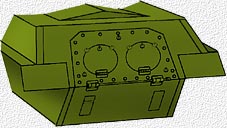 Shape of rear plate of first series tanks. |
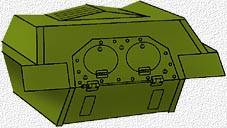 Shape of rear plate from 23.11.43 |
Nevertheless, the appearance of the turret was considerably changed in the process of its production. The first batch of tanks manufactured in 1943 had a narrow porthole through which the sighting telescope fits. After the installation of the D-25T Main Gun, it became almost impossible to use the telescopic sight, even though its breech was the same as that of the D-5T. Starting in May of 1944, a new turret with a widened porthole was manufactured, which resulted in the sight being moved to the left. The armour protection of the tank's mantlet was improved and the armour thickness of the sides of the lower hull was increased. The commander's cupola was shifted 63 mm to the left and the PT4-17 periscopic sight was changed to a MK-IV sight. A DShK anti-aircraft machine gun (designer P.P.Isakov) was installed on the commander's cupola. After that, no further significant changes were made to the turret until the end of the war. The last myth I would like to resolve: today some people often call a late-war JS-2 as JS-2m or JS-2M. In fact, JS-2m didn't exist whilst JS-2M appeared in 1950th after a serious moderinsation programm. Therefore, all war-time JS-2 tanks were only JS-2. |

Basic Modifications of the JS Series |
IS-1 and IS-85 are designations for the same tank. IS-122 and IS-2 are designations for the same tank. |
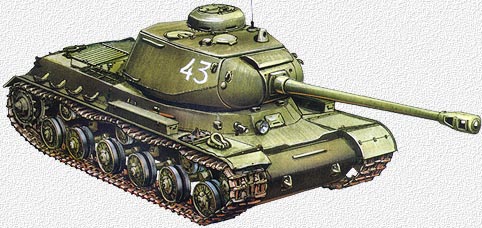


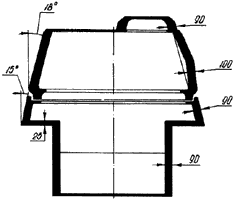
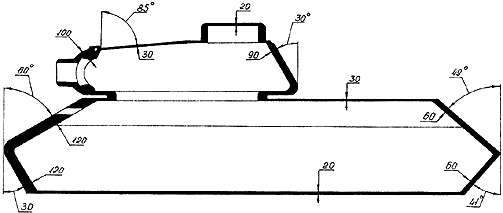
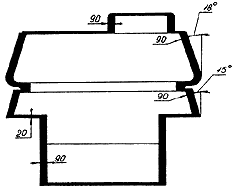
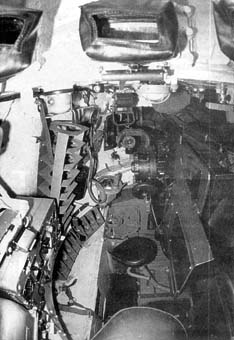 |
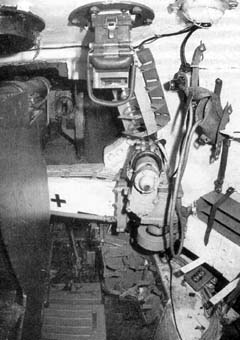 |
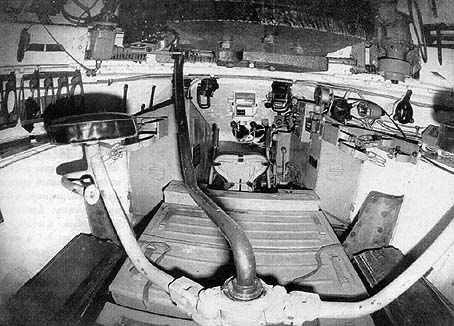 | |
Wrtitten by:
Valeriy Potapov Eugeni Boldyrev Translated by: Valeriy Potapov Proof-read by: Chris Amundson Sources: "The JS heavy tank", Manual, 1944; "Artillery armament for the Soviet tanks 1940-1945", Armada-Vertical #4, 1999; "Report of the artillery tests of the armor protection of JS-85 and JS-122", NII-48, Sverdlovsk, 1944; "A short technical report about the improving the armoring of the JS", NII-48, Sverdlovsk, 1944; "Studying the JS tanks being destroyed in summer-autumn 1944", NII-48, Sverdlovsk, 1945; "From the experiense of usage a tanks during the Great Patriotic War. Part I", 1946; "Heavy tanks and SP guns in action", NKTP, 1945; "About the tactic of the heavy tanksand SP guns during the street fighting", Handbook, 1945; M.Svirin "The JS tanks" Armada #6, 1998. |